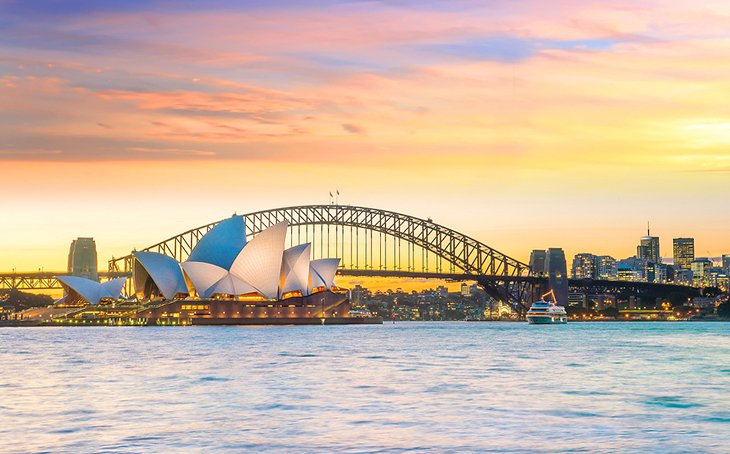Australia draws visitors from around the world with its striking landmarks, sweeping beaches, and breathtaking natural scenery. Your journey becomes even more memorable when you choose the right time to go. So, when is Australia at its best? Let’s explore.
1. Australia’s Climate
Australia is a vast country, covering more than 80% of the land area of Oceania. That size creates notable regional contrasts in weather and climate.
Coastal zones tend to be mild and temperate, while the interior can be hot and dry, with temperatures at times reaching up to 50°C. Australia is also among the driest countries on Earth, with average annual rainfall of roughly 600 mm.
As in other Southern Hemisphere countries, the seasons here are opposite to those in the Northern Hemisphere:
- Spring: September – November
- Summer: December – February
- Autumn: March – May
- Winter: June – August
2. Which Season Is Best for an Australia Trip?
There is no single “correct” answer, because Australia enjoys all four seasons and each paints the landscape in a different light. You can visit year-round and find beautiful scenery and engaging activities in every season.
That said, many travelers consider summer (December to February) especially appealing: warm to hot weather, lively coastal towns, and ideal conditions for beach time, snorkeling, and water sports.
2.1 Visiting Australia in Spring
Spring runs from September to November, when blossoms open across city streets and countryside alike. This is festival season, highlighted by Floriade in Canberra, the largest flower festival in Oceania.
The weather is gentle and comfortable, perfect for sightseeing and outdoor strolls. Under golden sunlight, you might catch an opera performance in Sydney, sip a fine glass of wine, or glide along the Margaret River for a relaxed day out.
Notable spring stops include:
- Jervis Bay: A classic seaside escape with crystalline water and long sweeps of white sand. Spring reveals striking coastal color and calm conditions for leisurely swims and coastal walks.
- Bacchus Marsh Orchards: The mild spring climate brings lush, heavy branches to the town’s orchards. Visitors can pick and taste ripe, fresh fruit right from the source.
- Canberra: Tucked between Melbourne and Sydney, the capital is serene yet vibrant in spring, when parks burst into color during the Floriade festival.
2.2 Visiting Australia in Summer
If you love adventure and the outdoors, summer is hard to beat. From December to February, beaches hum with energy, national parks are in full swing, and long days invite exploration.
Start by unwinding on Sydney’s beaches, tackle Tasmania’s famous Overland Track, or roam the scenic countryside around Melbourne. Summer is also a delicious season: think seafood feasts on South Australia’s Eyre Peninsula and crisp cool-climate wines in Tasmania.
Summer highlights:
- Great Barrier Reef: Off the Queensland coast, the world’s largest coral reef system comprises thousands of reefs and hundreds of islands. Snorkeling or diving here reveals an underwater world like no other.
- Bondi Beach: New South Wales’ iconic shoreline with clear water and powder-fine sand. Walk the cliff-top track for sweeping views of the Pacific.
- Tidbinbilla Nature Reserve: About 40 minutes from Canberra, this reserve shelters native wildlife and preserves important Indigenous heritage sites.
2.3 Visiting Australia in Autumn
Autumn stretches from March to May. Leaves turn red and gold, cool breezes return, and major events roll in — from the Formula 1 Grand Prix in Melbourne to food festivals and fashion weeks.
Travelers can wander through luminous conifer stands and misty valleys, especially around Victoria’s Yarra Valley, where crisp mornings set the tone for tranquil vineyard days.
Autumn ideas:
- Litchfield National Park: Home to waterfalls, wide pools, and rich wildlife. Autumn’s milder conditions make forest tracks and lookouts especially inviting.
- Brisbane River: A gentle cruise or riverside walk is an easy way to enjoy the season’s comfortable weather and the city’s relaxed atmosphere.
2.4 Visiting Australia in Winter
Prefer snow-dusted scenery and winter sports? Plan for June to August. This is peak ski season in the Australian Alps, where resorts buzz with activity.
In major cities such as Melbourne, Sydney, Canberra, and across Tasmania, winter temperatures typically range from about 3–15°C. Visitor numbers stay strong thanks to the popularity of snow sports and crisp, clear days ideal for urban exploring.
Winter favorites:
- Falls Creek: A well-known alpine resort with downhill skiing, snowboarding, and trails that trace scenic slopes.
- Simpson Mountains: In southern Australia, this area offers winter hikes and climbs for those who enjoy brisk air and rugged terrain.
In short, it’s tough to crown a single “best” season. Each part of the year shows Australia in a different mood, with distinctive landscapes and activities to match.
3. Practical Tips for Traveling to Australia
- Check the weather in advance: Conditions vary widely from region to region. Pack layers and gear suited to your route and season.
- Budget carefully: Australia can be expensive for visitors. Plan your finances and outline a clear itinerary to manage costs.
- Exchange currency ahead of time: Consider arranging currency exchange before departure to secure favorable rates.
- Follow customs regulations: Australia enforces strict biosecurity and import rules. Review the guidelines to ensure a smooth arrival.
With the pointers above, you can choose a time that fits your interests and make the most of your Australian journey, whether you seek beach days, alpine adventures, city festivals, or tranquil countryside escapes.










